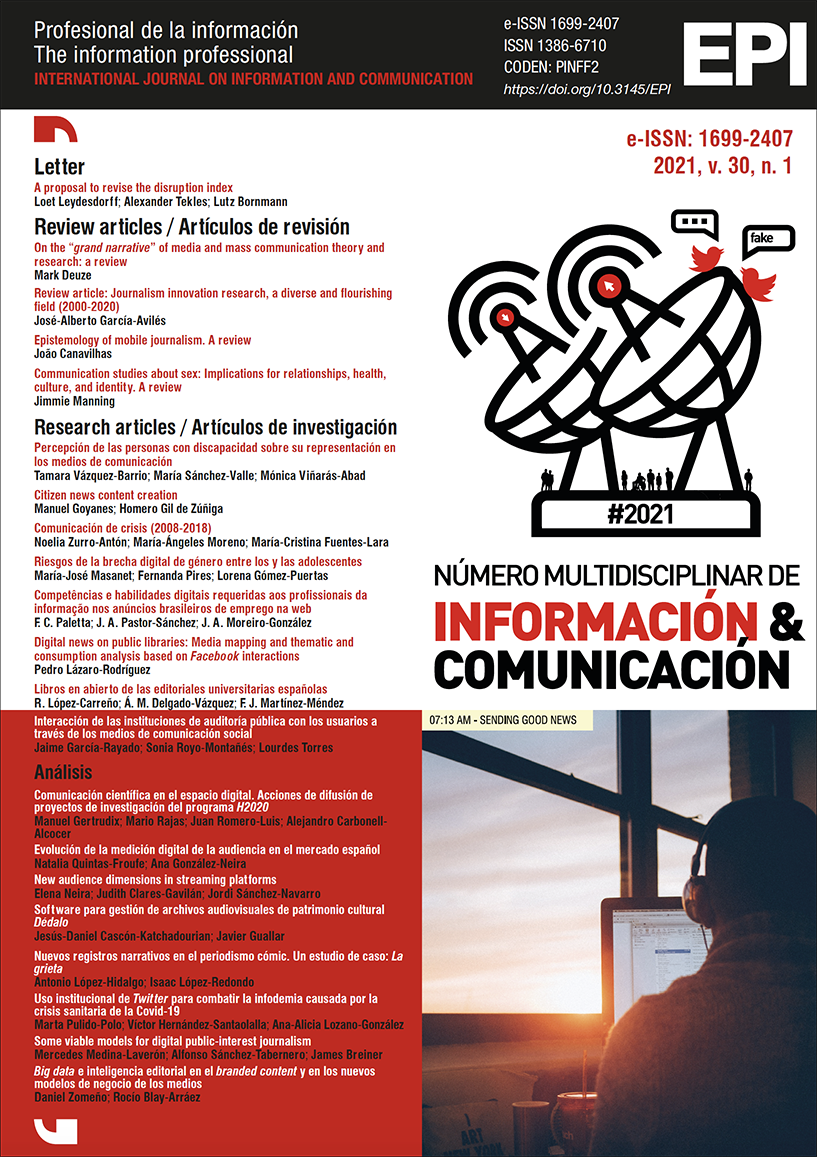A proposal to revise the disruption indicator
DOI:
https://doi.org/10.3145/epi.2021.ene.21Palabras clave:
Disruption, Consolidation, Indicator, Revision, Bibliographic couplingResumen
The disruption index (DI) based on bibliographic coupling and uncoupling between a document and its references was first proposed by Funk & Owen-Smith (2017) for citation relations among patents and then adapted for scholarly papers by Wu et al. (2019). However, Wu & Wu (2019) argued that this indicator would be inconsistent. We propose revised disruption indices (DI* and DI#) which make the indicator theoretically more robust and consistent. Along similar lines, Chen et al. (2020) developed the indicator into two dimensions: disruption and consolidation. We elaborate the improvements in simulations and empirically. The relations between disruption, consolidation, and bibliographic coupling are further specified. Bibliographic coupling of a focal paper with its cited references generates historical continuity. A two-dimensional framework is used to conceptualize dis-continuity not as a residual, but a dimension which can further be specified.
Descargas
Citas
Bornmann, Lutz; Devarakonda, Sitaram; Tekles, Alexander; Chacko, George (2020). "Disruptive papers published in Scientometrics: meaningful results by using an improved variant of the disruption index originally proposed by Wu, Wang, and Evans (2019)". Scientometrics, v. 123, pp. 1149-1155. https://doi.org/10.1007/s11192-020-03406-8
Bornmann, Lutz; Tekles, Alexander (2019). "Disruptive papers published in Scientometrics". Scientometrics, v. 120, pp. 331-336. https://doi.org/10.1007/s11192-019-03113-z
Bornmann, Lutz; Tekles, Alexander (2020). "Convergent validity of several indicators measuring disruptiveness with milestone assignments to physics papers by experts", arXiv:2006.10606. https://arxiv.org/abs/2006.10606
Bu, Yi; Waltman, Ludo; Huang, Yong (in press). "A multidimensional framework for characterizing the citation impact of scientific publications". Quantitative science studies. https://www.mitpressjournals.org/doi/abs/10.1162/qss_a_00109
Chen, Jiyao; Shao, Diana; Fan, Shaokun (2020). "Destabilization and consolidation: Conceptualizing, measuring, and validating the dual characteristics of technology". Research policy, v. 50, n. 1, art. 104115. https://doi.org/10.1016/j.respol.2020.104115
Funk, Russell J.; Owen-Smith, Jason (2017). "A dynamic network measure of technological change". Management science, v. 63, n. 3, pp. 791-817. https://doi.org/10.1287/mnsc.2015.2366
Garfield, Eugene; Pudovkin, Alexander I.; Istomin, Vladimir S. (2003). "Why do we need algorithmic historiography?". Journal of the American Society for Information Science and Technology, v. 54, n. 5, pp. 400-412. https://doi.org/10.1002/asi.10226
Glí¤nzel, Wolfgang; Schlemmer, Balázs; Thijs, Bart (2003). "Better late than never? On the chance to become highly cited only beyond the standard bibliometric time horizon". Scientometrics, v. 58, n. 3, pp. 571-586. https://doi.org/10.1023/B:SCIE.0000006881.30700.ea
Heinze, Thomas; Shapira, Philip; Senker, Jacqueline; Kuhlmann, Stefan (2007). "Identifying creative research accomplishments: Methodology and results for nanotechnology and human genetics". Scientometrics, v. 70, n. 1, pp. 125-152. https://doi.org/10.1007/s11192-007-0108-6
Kessler, Myer-Mike (1963). "Bibliographic coupling between scientific papers". American documentation, v. 14, n. 1, pp. 10-25. https://doi.org/10.1002/asi.5090140103
Leydesdorff, Loet (1991). "The static and dynamic analysis of network data using information theory". Social networks, v. 13, n. 4, pp. 301-345. https://doi.org/10.1016/0378-8733(91)90001-A
Leydesdorff, Loet; Wagner, Caroline S.; Bornmann, Lutz (2018). "Discontinuities in citation relations among journals: Self-organized criticality as a model of scientific revolutions and change". Scientometrics, v. 116, n. 1, pp. 623-644. https://doi.org/10.1007/s11192-018-2734-6
Tahamtan, Iman; Bornmann, Lutz (2018). "Creativity in science and the link to cited references: Is the creative potential of papers reflected in their cited references?". Journal of informetrics, v. 12, n. 3, pp. 906-930. https://doi.org/10.1016/j.joi.2018.07.005
Van Eck, Nees-Jan; Waltman, Ludo (2014). "CitNetExplorer: A new software tool for analyzing and visualizing citation networks". Journal of informetrics, v. 8, n. 4, pp. 802-823. https://doi.org/10.1016/j.joi.2014.07.006
Wu, Lingfei; Wang, Dashun; Evans, James A. (2019). "Large teams develop and small teams disrupt science and technology". Nature, v. 566, n. 7744, pp. 378-382. https://doi.org/10.1038/s41586-019-0941-9
Wu, Shijie; Wu, Qiang (2019). "A confusing definition of disruption". SocArxiv Papers. https://osf.io/preprints/socarxiv/d3wpk
Descargas
Publicado
Cómo citar
Número
Sección
Licencia
Condiciones de difusión de los artículos una vez son publicados
Los autores pueden publicitar libremente sus artículos en webs, redes sociales y repositorios
Deberán respetarse sin embargo, las siguientes condiciones:
- Solo deberá hacerse pública la versión editorial. Rogamos que no se publiquen preprints, postprints o pruebas de imprenta.
- Junto con esa copia ha de incluirse una mención específica de la publicación en la que ha aparecido el texto, añadiendo además un enlace clicable a la URL: http://revista.profesionaldelainformacion.com
La revista Profesional de la información ofrece los artículos en acceso abierto con una licencia Creative Commons BY.




